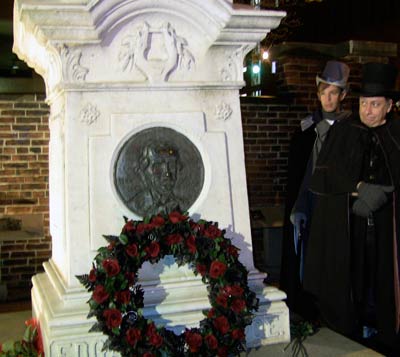A Birthday Observance for The Master of Macabre
Last Thursday evening 100 shivering revelers lined up outside the Westminster Burying Grounds in the bleakly quiet streets of West Baltimore. Far from somber, although many came dressed in black, the crowd members tittered and stamped their feet against the January chill, eager to celebrate the 203rd birthday of their favorite writer, Edgar Allan Poe, the master of the Gothic horror story.
At eight o'clock precisely, organizer Jeff Jerome swung open the iron gate and ushered everyone into the enclosure surrounding the granite monument to the author of "The Raven" and "Tell-tale Heart." This marked the largest turnout for the birthday celebration in the last 20 years, a tribute to Jerome's energy and Baltimore's enduring fascination with Poe.
"I think this proves beyond a doubt that people love Poe," says Jerome, the mid-60s curator of the Baltimore Poe House Museum. "The age diversity in this crowd tells me that tells me that we're doing the right thing in getting people interested in Poe."
"He is an amazing writer who has always inspired me," said 20-something Poe enthusiast Virginia, who declined to give her last name as did others at the event. "My poems and song lyrics all are influenced by Poe. He was the American writer that has stuck with me the most."
The event held particular resonance for Jerome this year because Baltimore city cut the Poe House's funding for the second year in a row, placing future Poe-related events at risk. As the Poe lovers assembled around him he seemed undaunted, not even tired after staying up all the night before waiting for the legendary Poe Toaster.
Beginning around the 1930s, a mysterious man started leaving three roses and a half empty bottle of cognac on Poe's grave during the early morning hours of January 19. Some speculate the roses are meant to represent Poe, his wife Virginia, and his  mother-in-law Maria—the two are buried next to him—and the cognac a nod to Poe's notorious drinking habits. The so-called Poe Toaster has not made an appearance since the writer's bicentennial. Nonetheless Jerome camped out in the adjacent Westminster Hall just in case. Only three imposters showed up. "The Poe Toaster tradition has ended," Jerome reluctantly conceded.
mother-in-law Maria—the two are buried next to him—and the cognac a nod to Poe's notorious drinking habits. The so-called Poe Toaster has not made an appearance since the writer's bicentennial. Nonetheless Jerome camped out in the adjacent Westminster Hall just in case. Only three imposters showed up. "The Poe Toaster tradition has ended," Jerome reluctantly conceded.
Once the crowd formed around Poe's gravesite, four actors appeared in black capes and top hats, each representing a character from a Poe's story.
"With a heart full of grief, yet reluctantly, and oppressed with awe, I made my way to the bed-chamber of the departed," read one of the actors who was portraying detective Le Chevalier C. Auguste Dupin from the 1835 short story Bernice. "The room was large, and very dark, and at every step within its gloomy precincts I encountered the paraphernalia of the grave." There wasn't a rustle in the crowd.
Although Poe remains celebrated for his horror tales such as this one, supporters say his expressive writing ignites a world of outlandish events and subsequent suspense—two characteristics of captivating storytelling. Poe fearlessly wrote about the macabre, inviting readers into the often disturbing worlds of his characters, staring right into the heart of madness, death, despair, and vengeance.
Baltimore has a particular claim on Poe, although other cities claim him as their native son: He was born in Boston, raised in Richmond, rented a home in Philadelphia, which is now a National Historic Site. But in Baltimore Poe allegedly wrote short stories The Visionary and Morella and poems "Latin Hymn" and "Fanny," among others. And it was here he died, too, under bizarre, still-unexplained circumstances. So Poe's spirit has long and deep roots here, far beyond just the naming of the city's professional football team, the Ravens.
With or without the closing of the Poe House, it seems that the author's legacy will last evermore.
